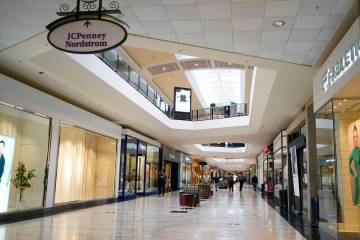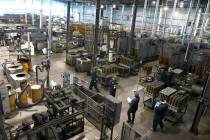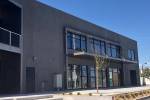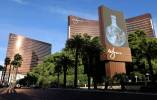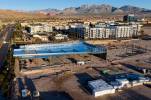Wide open spaces: Valley lacks large industrial spots
You might find it hard to believe Southern Nevada doesn’t have enough industrial space.
After all, 15 million square feet of buildings stand empty across the Las Vegas Valley, with a first-quarter vacancy rate of more than 17 percent.
That doesn’t mean the valley has the buildings it needs. For large users that need 200,000 square feet or more for regional logistics and distribution, there’s practically nothing.
It’s a shortage with important effects on economic diversification.
The Nevada Governor’s Office of Economic Development lists logistics and operations among the seven industries it is pinning its hopes on. It wants to attract warehousing, distribution and manufacturing plants to build on a small, existing base that includes Levi Strauss & Co.’s million-square-foot Henderson logistics center and Amazon.com’s 300,000-square-foot distribution plant in North Las Vegas.
But the valley is trapped in a vicious circle: It doesn’t have the big buildings it needs, yet overall high vacancy — almost all of it in smaller chunks unfit for regional or national logistics — means few banks will put capital on the line for any new square footage.
“It’s a chicken-and-egg problem. If you don’t build the space, companies have nothing to come look at, but no one will build on a speculative basis right now,” said Ben Millis, a director in the Las Vegas office of commercial brokerage Newmark Grubb Knight Frank.
The problem is worth solving because big logistics centers can employ 270 to 550 workers, said Dan Doherty, senior vice president with the Las Vegas office of commercial brokerage Colliers International.
Plus, Nevada’s consumer-oriented economy means lots of trucks arrive loaded but leave empty — a logistical reality that makes for especially affordable outbound shipping, Millis said.
Without a huge turnaround in the market’s health, or a carefully targeted marketing strategy, those advantages will go untapped, industry observers say.
To see how acute the problem is, consider the numbers.
Most regional logistics hubs need at least 200,000 square feet of space. As of May, Las Vegas had just 73 occupied or unoccupied industrial properties that size — a seriously small number for a market of 2 million people, Doherty said.
Narrow it down to empty buildings available for quick occupancy, and the stats are even worse.
After logistics company World Pack USA took over 303,000 square feet in northeast Las Vegas in April, the next biggest facilities on the market were a 214,000-square-foot center in North Las Vegas and a 200,000-square-foot building in southwest Las Vegas. After that, you’re looking at buildings of just 100,000 square feet, well below the 350,000-square-foot minimum most regional distributors prefer.
That lack of unoccupied inventory can make some businesses think twice about moving here. It takes at least a year to build from scratch, and companies aren’t sure what they’d be getting.
“There’s added risk. The owners are not kicking the tires right in front of you,” Doherty said. “You’re not looking at the owner and saying, ‘We could move these windows and add truck doors.’ Everything’s on paper. It makes everybody nervous — the tenant, the financial partners, the developer and the contractor.”
It’s even riskier to consider Las Vegas when nearby markets have space. Phoenix and Reno in particular have vast tracts of massive warehouses sitting idle and waiting for tenants, Doherty said.
“We’re the only market without standing inventory, so from the get-go, we’re in third place,” he said.
Throw in other problems, such as limited rail access and highways that don’t sync up with coastal ports, and it’s even harder to lure logistics hubs, Millis said.
To get past its shortcomings, Doherty said, Las Vegas has two choices: It can build more big warehouses on a speculative basis, without tenants lined up, or it can reach out to individual logistics companies and persuade them to wait out new build-to-suit construction.
For now, forget about the first option.
“The market’s negative (vacancy) figures definitely don’t entice a lender to enter into the arena,” said Robert Sandhu, vice president of commercial lending for First Savings Bank in Las Vegas.
The fact that 80 percent of leases written in the market are for less than five years hurts, too, because banks won’t lend on a project with a lease for fewer years than that, Millis said.
The likelier solution is to persuade businesses one by one to give Las Vegas a chance on build-to-suit projects, which banks are happy to finance for a creditworthy tenant that’s either buying or leasing long-term.
That worked with two recent big deals Doherty helped negotiate: The lease for World Pack, which distributes Pillow Pets toys, and an announcement by FedEx Ground that it will build a 296,000-square-foot logistics center in Henderson’s South 15 Industrial Center. FedEx’s project will replace its 130,000-square-foot space near Sunset and Eastgate roads in Henderson.
Allison Houser, a FedEx Ground spokeswoman, said the company chose the new site for its easy access to highways. She also noted that the area has a large labor pool for recruiting.
Southern Nevada has a few other aces in its hole. An acre of industrial land costs about $150,000 these days, down from $600,000 during the boom, Millis said.
Even better, it takes less time to get a project permitted, said Curtis Allsop, director of the land group at Newmark Grubb Knight Frank. The process takes about six months here and 18 to 24 months in Phoenix or California.
Given the market’s inventory limits, the “best thing we can do is go to California, Salt Lake City or Phoenix, find end users and convince them this is a better place to be,” Millis said. “We can find land and build them the large distribution centers they need. We can’t build it and hope they will come. But they will build if we can get them here.”




